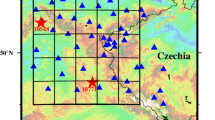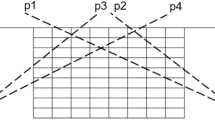Abstract
This paper presents a novel approach for assessing the precision of the wet refractivity field using BDS (BeiDou navigation satellite system) simulations only, GPS, and BDS+GPS for the Shenzhen and Hongkong GNSS network. The simulations are carried out by adding artificial noise to a real observation dataset. Instead of using the d and s parameters computed from slant wet delay, as in previous studies, we employ the Bias and RMS parameters, computed from the tomography results of total voxels, in order to obtain a more direct and comprehensive evaluation of the precision of the refractivity field determination. The results show that: (1) the precision of tropospheric wet refractivity estimated using BDS alone (only 9 satellites used) is basically comparable to that of GPS; (2) BDS+GPS (as of current operation) may not be able to significantly improve the data’s spatial density for the application of refractivity tomography; and (3) any slight increase in the precision of refractivity tomography, particularly in the lower atmosphere, bears great significance for any applications dependent on the Chinese operational meteorological service.
Similar content being viewed by others
References
Bender, M, and Coauthors, 2009: Estimates of the information provided by GPS slant data observed in Germany regarding tomographic applications. J. Geophys. Res., 114(2009), D06303, doi: 10.1029/2008JD011008.
Bender, M., G. Dick, M. Ge, Z. Deng, J. Wickert, H.G. Kahle, A. Raabe, and G. Tetzlaff, 2011a: Development of a GNSS water vapour tomography system using algebraic reconstruction techniques. Adv. Space Res., 47(10), 1704–1720.
Bender, M., R. Stosius, F. Zus, G. Dick, J. Wickert, and A. Raabe, 2011b: GNSS water vapour tomography—Expected improvements by combining GPS, GLONASS and Galileo observations. Adv. Space Res., 47(5), 886–897.
Bevis, M., S. Businger, T. A. Herring, C. Rocken, R. A. Anthes, and R. H. Ware, 1992: GPS meteorology: Remote sensing of atmospheric water vapor using the Global Positioning System. J. Geophys. Res., 97, 15 787–15 801.
Bevis, M., S. Chiswell, and S. Businger, 1995: GPS/STORM: GPS sensing of atmospheric water vapor for meteorology. J. Atmos. Oceanic Technol., 12, 468–478.
Flores, A., G. Ruffini, and A. Rius, 2000: 4D tropospheric tomography using GPS slant wet delays. Annales Geophysicae, 18(2), 223–234.
Gutman, S. I., S. R. Sahm, S. G. Benjamin, B. E. Schwartz, K. L. Holub, J. Q. Stewart, and T. L. Smith, 2004: Rapid retrieval and assimilation of ground based GPS precipitable water observations at the NOAA forecast systems laboratory: Impact on weather forecasts. J. Meteor. Soc. Japan., 82, 351–360.
Hirahara, K., 2000: Local GPS tropospheric tomography. Earth, Planets and Space, 52(11), 935–939.
Liu, J., Z. Sun, H. Liang, X. Xu, and P. Wu, 2005: Precipitable water on the Tibetan Plateau estimated by GPS, water vapor radiometer, radiosonde, and numerical weather prediction analysis and its impact on the radiation budget. J. Geophys. Res., 110, D17106. doi: 10.1029/2004JD005715.
Ma, J., S. H. Tang, Y. Huang, and W. J. Wang, 2011: IGS precise ephemeris based on the comparison of the ways for the satellite position interpolation. Urban Geotechnical Investigation & Surveying, 5, 89–93. (in Chinese)
Nilsson, T., and L. Gradinarsky, 2006: Water vapor tomography using GPS phase observations: Simulation results. IEEE Trans. Geosci. Remote Sens., 44 (10 Part 2), 2927–2941.
Notarpietro, R., M. Cucca, M. Gabella, G. Venuti, and G. Perona. 2011: Tomographic reconstruction of wet and total refractivity fields from GNSS receiver networks. Adv. Space Res., 47, 898–912.
Perler, D., A. Geiger, and F. Hurter, 2011: 4D GPS water vapor tomography: New parameterized approaches. Journal of Geodesy, 85(8), 539–550.
Rocken, C., R. Ware, T. V. Hove, F. Solheim, C. Alber, J. Johnson, M. Bevis, and S. Businger, 1993: Sensing atmospheric water vapor with the Global Positioning System. Geophys. Res. Lett., 20, 2631–2634.
Rocken, C., T. V. Hove, and R. Ware, 1997: Near real-time GPS sensing of atmospheric water vapor. Geophys. Res. Lett., 24(24), 3221–3224.
Rohm, W., and J. Bosy, 2009: Local tomography troposphere model over mountains area. Atmospheric Research, 93(4), 777–783.
Rohm, W., and J. Bosy, 2011: The verification of GNSS tropospheric tomography model in a mountainous area. Advances in Space Research, 47(10), 1721–1730.
Shi, C., and Coauthors, 2012: Research on precise orbit determination and positioning of Compass Satellite Navigation System. Science China: Earth Science, 42(6), 854–861. (in Chinese)
Wang, W., and J. X. Wang, 2011: Tropospheric water vapor tomography based on algebraic reconstruction techniche. Journal of Computer Applications, 31(11), 3149–3156. (in Chinese)
Author information
Authors and Affiliations
Corresponding author
Rights and permissions
About this article
Cite this article
Wang, X., Wang, X., Dai, Z. et al. Tropospheric wet refractivity tomography based on the BeiDou satellite system. Adv. Atmos. Sci. 31, 355–362 (2014). https://doi.org/10.1007/s00376-013-2311-0
Received:
Revised:
Accepted:
Published:
Issue Date:
DOI: https://doi.org/10.1007/s00376-013-2311-0




